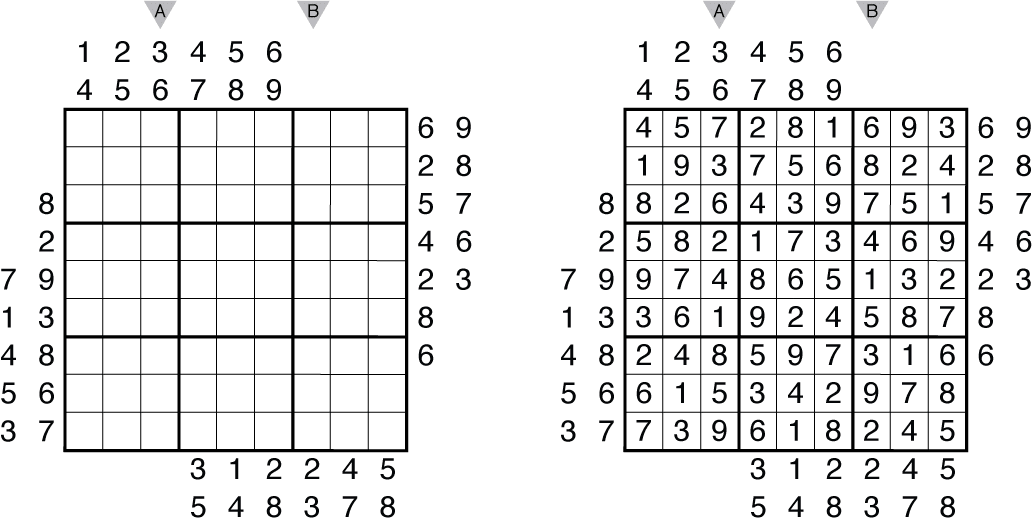
and titled "Kashikoku naru Puzzle" ( 賢くなるパズル, Kashikoku naru pazuru, lit. In 2007, toy inventor Robert Fuhrer, owner of Nextoy and creator of Gator Golf, Crocodile Dentist, and dozens of other popular toys and games, encountered KenKen books published in Japan by the educational publisher Gakken Co., Ltd. Some puzzle authors have not done this and have published puzzles that use more than two cells for these operations. Hence if the target is 1 and the operation is - (subtraction) and the number choices are 2 and 3, possible answers are 2,3 or 3,2. In the English-language KenKen books of Will Shortz, the issue of the non- associativity of division and subtraction is addressed by restricting clues based on either of those operations to cages of only two cells in which the numbers may appear in any order. The target number and operation appear in the upper left-hand corner of the cage. No operation is relevant for a single-cell cage: placing the "target" in the cell is the only possibility (thus being a "free space"). Digits may be repeated within a cage, as long as they are not in the same row or column. For example, a linear three-cell cage specifying addition and a target number of 6 in a 4×4 puzzle must be satisfied with the digits 1, 2, and 3. Additionally, KenKen grids are divided into heavily outlined groups of cells –– often called “cages” –– and the numbers in the cells of each cage must produce a certain “target” number when combined using a specified mathematical operation (one of addition, subtraction, multiplication or division). –– so that no digit appears more than once in any row or any column (a Latin square). General rules Īs in Sudoku, the goal of each puzzle is to fill a grid with digits –– 1 through 4 for a 4×4 grid, 1 through 5 for a 5×5, 1 through 6 for a 6×6, etc.

The names Calcudoku and Mathdoku are sometimes used by those who do not have the rights to use the KenKen or KenDoku trademarks. The name derives from the Japanese word for cleverness ( 賢, ken, kashiko(i)). KenKen and KenDoku are trademarked names for a style of arithmetic and logic puzzle invented in 2004 by Japanese math teacher Tetsuya Miyamoto, who intended the puzzles to be an instruction-free method of training the brain. For other uses, see Kenken (disambiguation).
Rules of sudoku series#
the length of a 1-3-6 series is 3.)įirst seen odd/even Sudoku: If odd, the first odd number in the corresponding direction or, if even, the first even number.This article is about the puzzle. MaxAscending Sudoku: The length of the longest series of ascending digits in the corresponding direction. Higher skyscrapers block the view of lower ones, size being given by the digit. Skyscraper Sudoku: The number of visible skyscrapers from that side. Next-to-6 Sum Sudoku: The sum of all direct neighbours of the digit 6 in the row or column. Outside-2 Sudoku: Must be placed in one of the first two cells in the corresponding direction. Outside clues per variant show:ĭifference Sudoku: The difference of the first two digits in the corresponding direction. Normal 6圆 sudoku rules apply to all sudokus, so each row, column and region must contain 1-6. A circle is an outside clue for both adjacent puzzles.

This is one large puzzle, consisting of six different variants of 6圆 sudokus, all linked together by circles. May not work on non sudoku grids or special constraints. Hotkeys Selection Select cells + Mouse click/drag Add or remove from current selection Move selection +, + Add to current selection + Select all cells + + Deselect all cells + Invert selection, Tool sensitive selection Number Entry Insert value, pencil mark, candidate or colour Insert value, pencil mark, candidate or colour Button Insert value, pencil mark, candidate or colour Change Tool, Next mode +, Previous mode "Digit" mode ( on German keyboard layout) "Corner" mode "Centre" mode "Colour" mode + Enter digit in "centre" mode + Enter digit in "corner" mode + + Enter digit in "colour" mode Undo / Redo + Undo last action + Redo last action if it was undo Check finished puzzle Button Press the check button to test basic sudoku rules.


 0 kommentar(er)
0 kommentar(er)
